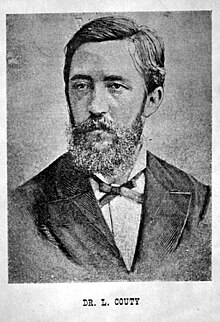20:
171:
He died unexpectedly at 30 years of age, after living less than 8 years in Rio, and his brilliant career, which could have been so important to the development of
Brazilian physiology, was cut short. Couty's place in the history of biomedical science is preserved in a fresco painting at the entrance
148:, writing in 1881 an important book, one of the earliest sociological analyses published about the country, "Slavery in Brazil". In this work, Couty proved that Brazil, on the basis of the
81:. Disappointed with its local conditions, he asked to carry out his experimental research at the National Museum, where Lacerda was already active with a research line on
264:
239:
259:
214:
70:
110:
visited the
Laboratory and invited him to be its first director, providing also the necessary resources to support the research lines.
173:
234:
160:
owners (only about 500,000 in 12 million total, in a land of 5 million square km) were the "real" economical and political
244:
78:
59:
103:, and his first published paper was on its physiological properties, in 1876. Hearing about his work, the Brazilian
55:
254:
249:
107:
43:
113:
Couty also did experiments on other toxic plants and animals, the physiological effects of
122:
215:
The
Laboratory of Experimental Physiology, Imperial and National Museum of Rio de Janeiro
197:
133:
85:
66:
39:
228:
153:
118:
51:
130:
145:
47:
219:
Dicionário Histórico-Biográfico das Ciências da Saúde no Brasil (1832-1930)
19:
157:
114:
104:
74:
31:
149:
141:
126:
100:
93:
35:
161:
137:
97:
89:
82:
18:
62:(1846-1915), a Brazilian physiologist who was the lab's founder.
221:. Casa de Oswaldo Cruz, Fiocruz, Rio de Janeiro (In Portuguese).
54:. He worked at the Laboratory of Experimental Physiology at the
58:, the first of its kind in Brazil. He was a collaborator of
73:(1817–1894). He came to Brazil to lecture on Industrial
8:
185:
172:of the basic sciences building of the
7:
152:of 1872, had a very small organised
79:Escola Politécnica do Rio de Janeiro
14:
144:and even adventured himself into
56:National Museum of Rio de Janeiro
16:French physician and physiologist
174:Federal University of São Paulo
265:Expatriate academics in Brazil
240:19th-century French physicians
1:
164:. Hence, his famous boutade,
71:Charles-Édouard Brown-Séquard
65:Couty studied in France with
260:French expatriates in Brazil
281:
60:João Baptista de Lacerda
136:, etc. He also studied
92:. Couty began to study
235:French pharmacologists
166:"Brazil has no people"
38:– 22 November 1884 in
24:
192:"Le Dr Louis Couty",
22:
245:French physiologists
30:(13 January 1854 in
25:
272:
202:
201:
196:, 1 August 1911
194:Limoges Illustré
190:
69:(1826–1887) and
44:Empire of Brazil
280:
279:
275:
274:
273:
271:
270:
269:
225:
224:
211:
206:
205:
199:
191:
187:
182:
46:) was a French
17:
12:
11:
5:
278:
276:
268:
267:
262:
257:
252:
247:
242:
237:
227:
226:
223:
222:
210:
209:External links
207:
204:
203:
184:
183:
181:
178:
140:physiology in
67:Alfred Vulpian
40:Rio de Janeiro
15:
13:
10:
9:
6:
4:
3:
2:
277:
266:
263:
261:
258:
256:
253:
251:
248:
246:
243:
241:
238:
236:
233:
232:
230:
220:
216:
213:
212:
208:
198:
195:
189:
186:
179:
177:
175:
169:
167:
163:
159:
155:
151:
147:
143:
139:
135:
132:
128:
124:
120:
116:
111:
109:
106:
102:
99:
95:
91:
87:
84:
80:
76:
72:
68:
63:
61:
57:
53:
49:
45:
41:
37:
33:
29:
21:
218:
193:
188:
170:
165:
154:middle class
119:pharmacology
112:
108:Dom Pedro II
64:
52:physiologist
27:
26:
255:1884 deaths
250:1854 births
200:(in French)
28:Louis Couty
23:Louis Couty
229:Categories
180:References
131:sugar cane
88:and other
156:and that
146:sociology
117:, on the
48:physician
142:monkeys
134:alcohol
115:climate
105:emperor
77:at the
75:Biology
32:Nantiat
150:census
127:coffee
101:poison
94:curare
90:toxins
36:France
162:elite
158:slave
138:brain
98:plant
86:venom
83:snake
123:mate
96:, a
50:and
121:of
231::
217:.
176:.
168:.
129:,
125:,
42:,
34:,
Text is available under the Creative Commons Attribution-ShareAlike License. Additional terms may apply.
